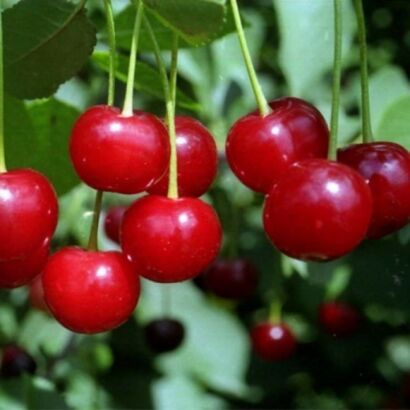Cherry Generous
Variety: partially self-fertile
Fruits: 3.2-4 gr., dark red.
Ripening period: late, extended
Yield: 10-15 kg/tree
Growing conditions: all regions
Selection: Ural
| Ripening period | Late-ripening variety |
| fruit size | Traditional varieties |
| Productivity: | high |
| Selection | Russia |
| planting material | Cherry |
Shchedraya cherry cultivar was bred by breeders of the Ural Agar Research Institute (Yekaterinburg) by natural pollination of "Ideal" cherries. with other varieties. In 1959, "Generous" included in the State Register with permission to grow in all regions of the Russian Federation, including the northern latitudes, Siberia and the Far East.
Variety advantages: high winter hardiness, regular fruiting, compact crown, fruits do not crack. Weak spot – extended fruit ripening period.
Characteristics of the variety
Shrub weak, 1.5 meters high. The basis of the elevated part of the cherry – trunk with several perennial shoots. The crown is compact, which is convenient when harvesting. The root system is well developed, up to 2.5 m deep. Foliage petiolate with serrated edges. Fruiting occurs on annual growths and bouquet branches. The life cycle of a plant is about 35 years.
Fruits rounded, even, weighing 3.2-4 g. The skin is shiny, dark red. The pulp is juicy, sweet and sour. The bone is semi-separable. The stem is tightly attached to the berry.
"Generous" classified as table varieties. Cherries are consumed fresh, processed into juices, jams, wines, etc. Fruit transportability is good, the berry is suitable for growing for sale.
Productivity annual, up to 10-15 kg per tree. The ripening period of cherries is stretched, from July to September. The crop is harvested in 2-3 passes.
Immunity. Medium resistance to coccomycosis and clasterosporiasis. Dangerous pests – aphids and slimy sawfly. Preventive treatment of trees is necessary.
Growing conditions. Cherry variety «Generous» – winter-hardy (up to -45°C without shelter) and drought-resistant. Therefore, the plant develops well and yields both in southern and northern latitudes.
Basic vertical root "Generous" grows up to 2.5 meters in depth, so the plant tolerates a lack of moisture well. The tree needs 3 waterings per season: during the periods of flowering and fruit ripening, as well as after harvesting. With a prolonged drought, cherry seedlings are watered at least 5 times during the summer.
"Generous" partially self-fertile – without pollinators forms only 10-20% of ovaries. To increase yields, cherry trees are planted nearby for cross-pollination. Suitable varieties that bloom at the same time (late May & early June).
Preparations
| Phase | Operation | Biopreparations | Comment |
|---|---|---|---|
| Pre-plant tillage | Disease treatment | SBT-Trichodermin TH82 | Fight against overwintering forms of pathogens 30-100 g/20 l of water per 1 weave |
| top dressing | SBT-Ekosoil | Stimulation of biological activity 50 g per 20 l of water / 1 weave |
|
| root formation | Disease treatment | SBT-Fitolek BS26 | Soaking the roots of seedlings Prevention of the development of a wide range of fungal diseases 60 g/10 l for 50 pcs. seedlings |
| SBT-Trichodermin TH82 | Prevention of the development of a wide range of fungal diseases. Soaking the roots of seedlings 60 g/10 l for 50 pcs |
||
| Bloom | Disease treatment | SBT-Trichodermin TH82 | Prevention of late blight, powdery mildew, root rot, gray mold, leaf spot 40 g/10 l per 100 m2 |
| SBT-Fitolek BS26 | Processing in the budding phase Prevention of powdery mildew, alternariosis, anthracnose, fomopsis, gray mold, curliness, septoria, tuberculariasis 40 g / 10 l per 1 weave |
||
| Pest control | SBT-Actaro E | Processing in the budding phase Control of pests weevils, bronzovka, mites, aphids, sawflies. 10 g/10 l per 1 weave |
|
| After harvest | Disease treatment | SBT-Trichodermin TH82 | Autumn processing Reducing the stock of overwintering forms of pathogens spraying 120 g per 10–15 liters per 1 weave |
